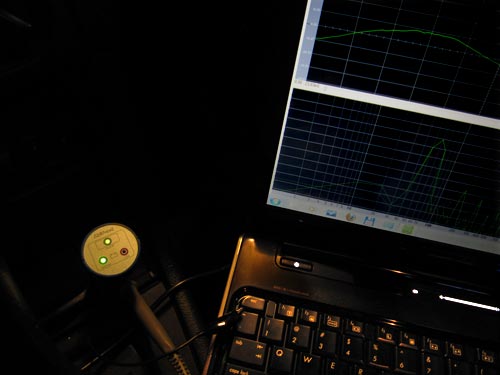
The FuelDoctor FD-47 is a device that can help increase fuel economy by conditioning electrical signals (e.g., aberrant noise, harmonics, spikes). It consists of a set of electronics filters encapsulated in a shell that is inserted into the cigarette lighter of the car. The concept is sound: filter out transient spikes and help the electronic control unit of the car function more efficiently and, ergo, improve fuel use.
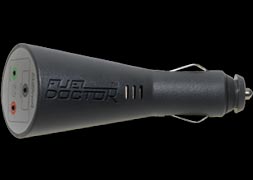
I’m not overly happy with the fuel economy of my vehicle so I was very interested in seeing how much improvement I could get. I’m also amused by people who claim (very vocally, in fact) that there is no possible way that that thing could work and that there is no way they would allow it attached to their vehicle. Whatever. Let’s see how many big bucks this thing saved me.
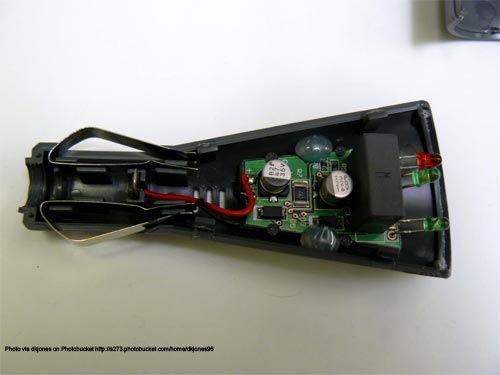
The FuelDoctor is inserted into the cigarette lighter of the car. A power indicator light and a battery charge light illuminate when the car is running, letting you know that signals are getting to the FuelDoctor.
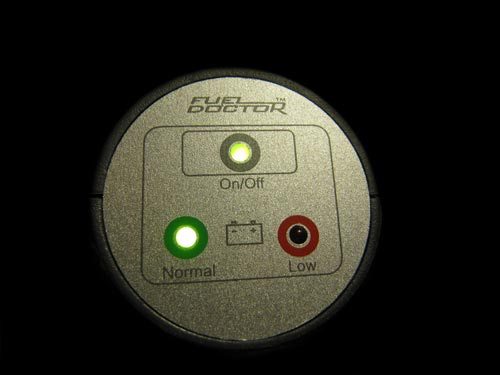
Since many of us use the cigarette lighter for charging USB devices or brewing coffee, the company also sells a dual socket adapter and USB port (both sold separately). (It’s important to note that these accessories do not contain the FuelDoctor electronics; that threw me off since the company sent all three items and I assumed that the accessories were also FuelDoctors. Only after taking apart the dual socket did I realize that they were not actual FuelDoctors. Just an FYI.)
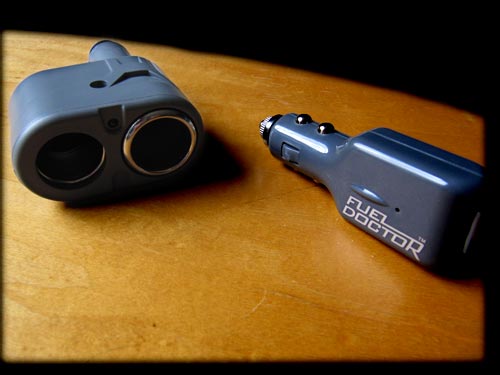
I used the FuelDoctor on a standard transmission 2006 Subaru Baja. I used it for both highway and city driving for 30 days (the amount of time provided for the product’s guarantee) but didn’t see any fuel-use improvement. This could be because the car is still too new to have developed any electrical pollution that could affect the electrical system. However, several newer vehicles were reported to have increased fuel economy according to the technical sheets on the FuelDoctor web site. My normal fuel mileage is from 21-24 MPG city and from 25-29 MPG highway. With or without the FuelDoctor, the mileage remained in that range. Disappointing.
So a friend offered to use the FuelDoctor on his 2003 GMC Sonoma. He commutes about 80 miles every day to and from work so we thought this would be an interesting test. He too, however, reported that there was no significant difference in his fuel mileage. He did report, though, that when driving at 55 MPH, his fuel economy went up significantly. But I can’t drive 55.
For a final test, I cobbled up a PC oscilloscope probe and a copy of Visual Analyzer to monitor the voltage and frequency spectrum at the cigarette lighter port with and without the FuelDoctor. This too was inconclusive since my diagnostic hardware didn’t show anything nearly as obvious as the photo on the FuelDoctor website.
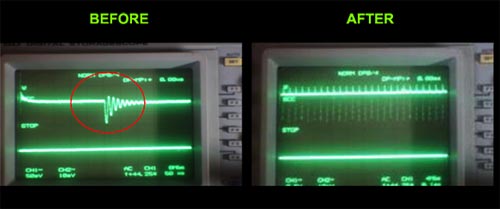
There are some compelling technical test results on the FuelDoctor web site, a summary of which is provided in the following table, but it appears that for the bottom line, your results will vary depending on your vehicle. Since the product comes with a 30-day guarantee, it doesn’t hurt to try it out.
| Make/Model | Year | %Increase in MPG |
| Ford Focus | 2004 | 16% |
| Mazda 6 | 2007 | 13% |
| Mazda 3 | 2007 | 19% |
| Honda | 1996 | 21% |
| Subaru Legacy | 1996 | 32% |
| Honda | 2000 | 21% |
| Honda CR-V | 2001 | 12% |
| Toyota Vios | 2005 | 31% |
| Toyota D4D | 2000 | 13% |
| Isuzu Truck | 2006 | 7% |
| Toyota Camry | n/a | 36% |
| Honda | 1996 | 21% |
| Toyota Truck | 2003 | 12% |
| Honda CR-V | 2001 | 12% |
| Toyota Camry | 2008 | 23% |
| Isuzu DMax | 2006 | 20% |
| Honda | 1996 | 22% |
Table extracted from various technical sheets found on the FuelDoctor web site.
Gerber Gear 22-47162N Fast Draw Folding Assisted Opening Pocket Knife, Fine Edge, Black
7% OffGerber Gear EVO Jr. Folding Knife - Serrated Edge [22-41493]
$28.99 (as of October 24, 2025 18:39 GMT -04:00 - More infoProduct prices and availability are accurate as of the date/time indicated and are subject to change. Any price and availability information displayed on [relevant Amazon Site(s), as applicable] at the time of purchase will apply to the purchase of this product.)Product Information
| Price: | $59.95 |
| Manufacturer: | FuelDoctor |
| Pros: |
|
| Cons: |
|




Gadgeteer Comment Policy - Please read before commenting
This type of device has no ability to do anything since it is plugged to a lighter port.
Have tested there type of products for customers before at my shop.
Most new vehicles already squeeze out as much as possible out of the fuel mileage.
Drive 55 ,keep your tires inflated ,to specs and you will see better fuel economy.
Al
The concept is not sound. If electric system spikes had an impact on fuel economy, they’d need to be managed at the alternator, not downstream at a 12v outlet. Of course the “test results” are “compelling” from the manufacturer’s website. Your own experience flies in the face of their claims, yet you still seem to want to give them the benefit of a doubt.
Supposedly, FuelDoctor has provided the device to Consumer Reports for testing. I wouldn’t spend a red cent until a credible independent tester evaluates the device. I think the FuelDoctor is engineered to extract money from the gullible, and it’s probably really effective at that.
Two words: Deer Whistle.
Still, thanks for a thorough review, cobinrox! 🙂
There are many products that claim to improve fuel-economy by 5-10% and the vast majority of them do nothing other than lighten the wallet (which may have an effect, but only if you paid with the thousands of pennies you would otherwise keep in there).
I suspect that whatever fuel economy improvements are probably caused by the burning of snake oil.
Thanks for testing though.
I worked for one of the big three automotive companies for many years. We spent many, many millions of dollars on R&D and I can guarantee that if ANYTHING like this was even remotely plausible, we would long ago have incorporated it into all of our cars and been featuring it in all of our advertising. NO car company would pass up the opportunity to deliver 20 or 30% better mileage than their competitors.
Also, I know for a fact that all of the vehicle electronics are already heavily shielded against any kind of electronic interference, but even if they weren’t, any kind of fix would have to be directly between the alternator and the device supposedly being protected – NOT off on a branch circuit.
It’s disappointing to see something so ludicrous on Gadgeteer.
I expect more credulity from you guys.
I’m actually slightly sad to see that a highly respected site such as The Gadgeteer a) bothers to test such an obvious hoax and b) even after testing the product still believes in the marketing claims.
@Ray & Kalle we’re here to review things people are curious about. You see products like these on TV and the internet everyday. This review actually tested one and showed the results.
The best way to save fuel is by using your right foot wisely: accelerate normally, shift-up early (in case of a manual gear shift), don’t drive too fast, and use the cruise control. By driving like this, I get 15 km to a liter fuel (=35 mpg). My wife has a somewhat “sportier” driving style and refuses to use the cruise control. She barely gets 13 km/L (=130 mpg). So by just driving less sporty, you can increase your km to liter ratio by 16 percent (from 13 to 15 km/L).
And like Al said: make sure the tires are inflated at the right pressure. Some other tips: drive with the windows closed, don’t use the air conditioning if not necessary, anticipate to traffic lights (and to traffic in general) to maintain a constant speed, avoid hauling unneeded stuff in your car (some people stack half a household in their car).
You tested an obviously sham product that can’t possibly work, had you (1) consulted an electrical engineer, or (2) spent 10 minutes educating yourself about electrical circuitry. When the product didn’t work, you let a friend test it on a second vehicle. When the product STILL didn’t work you tested it on an oscilloscope, found that it didn’t even work there (much less do anything to a car’s engine electrical current while plugged into a 12v outlet). THEN conclude “your mileage may vary,” and “It can’t hurt to try.” WTF? IT’S A SHAM. SAY SO.
Hey so could someone explain me why this is “obviously” a sham or hoax product rather than just stipulating that it is? I’m the first to state that “yeah it didn’t improve my car’s mileage”, but I’ve spent a lot of time analyzing circuits (and yes i AM an electrical engineer) and know that noise is as insidious as dirt in an open wound and varies just like fingerprints on a murder weapon (ok never mind that last remark — i don’t know anything about such weapons, really, seriously, i mean it). Also, if you get a chance, take a closer look at the documentation — it’s meant to filter out crap going to the ECU, not meant to filter out anything from the alternator.
Anyway, let us all know why it is a hoax, a sham, can’t possibly work, why I’m an idiot (ok, never mind i already know that one), and, if it is physically impossible for it to work, why did it work for the group of vehicles for the various test organizations?
Let’s all try to help others (myself included) understand how to analyze a product and its claims rather than just pee on it without consideration and run off into the night … like some hottie vampire with great abs and cute English accent and surfer hair (ok never mind that too).
@cobinrox
Agreed, all these people who are hating on it havent even tried it! They should try it and then come back here to report their findings…not just make unsubstantiated statements
Can somebody please explain how power from an auxiliary power source is supposed to make its way back to the ECU? I’m not an electrical engineer, nor am I an ACE certified mechanic. I do, however, think I have common sense and I like to tinker with autos. So here is my common sense, no educational background thought on this.
Electrical power is run fed off the alternator through the battery to the main distribution fuse panel which parses off electricity to the various components of the vehicle. This may in fact be erroneous but keep in mind my previous disclaimers that I am not educated… moving on. Given that fuel injectors are a critical component, I would assume that they have a dedicated circuit in an attempt to prevent any type of voltage or amperage drops while driving. With this assumption, I surmise that the circuit doesn’t have any connection to the auxiliary power users such as the radio, the 12v power plug, cruise control, HVAC, etc. Now that I have explained my thoughts, could somebody please correct my electrical diagram to somehow show a direct correlation to how this will smooth out electrical currents to the ECU then on to the fuel injectors? It would seem that there would only be two points which would have a potential impact for smoothing out current (if that matters at all) near the source of the current, or to me even better near the termination of the current close to the component which requires smooth current. Although in most cases the latter would be counter-intuitive, I am making the assumption that the current could again become turbulent after passing through its various stops before the fuel injectors.
I am disappointed that you blindly accept the claims of the manufacturer. I can’t conclude the veracity of their claims but I typically don’t accept foreign testing with name brands slapped on a powerpoint as a conclusive test to sway my opinion. As other have stated, why would such a device not already be installed if it is A) so cheap and B) uses existing technology?
Just my thoughts, please get back with me on these issues. I would hope that the author of this article would reply to me as an electrical engineer, I’m sure he/she has insight. Although, as an engineer, I would hope that the new response would contain less witty, unrelated remarks and more scholarly verbiage. I do agree that what do you have to lose with a 30 money back guarantee but even then, from a less than reputable company (if indeed this is one) it may be difficult to recover the loss.
Cheers all, I enjoyed the lively debate.
Yah, i don’t think anyone knows how this thing works!
It does NOT work… This scam started in Thailand under a company called WorldPRO and they produced this thing called the WORLD PRO- PROReducer, which was nothing more than a Sony Ericsson car charger. The original product even had the original “Plug in fast charger” sticker still on it when they were selling it in Thailand with a piece of tape over the USB type plug. Since then, the scam has evolved into the Fuel Doctor… Simply go to this website and you will see how it works, how they manufacture it, how it evolved and where it came from…
http://www.compendiumarcana.com/fuel_doctor_fd47/
cobinrox, you amaze me. You and a friend both use this device, find no positive effect, and yet despite the fact that this devices has been shown to be a sham by several respected testing organization, you still say “it’s worth a try?” Dear god, what would it take to make you interpret your results as what they were, a total failure? Even if it does filter out noise, where’s the data/evidence that such noise has any effect on fuel mileage in a car? Do you really think that car manufacturers are building ECU’s that don’t already filter out any noise that would screw with the mileage results? Simply stunning that an electrical engineer could come up this this review.
Oh, and cobinrox, any reply to Larry’s link to the analysis of the FD contents?
Additionally, I went off on these IDIOTS! I went off to the point of them suing me… Basically their ‘product’ is a scam straight up! That is the bottom line… First, the 12 Volt outlet is an OUTLET!!! Plain and simple. This product does not violate Ohm’s law and send electricity the opposite direction. I went through basic electrical theories and Ohm’s law and their product violates every aspect of it. So, I was prepared to go before a jury, without even a technical expert because it is so easy to prove they are full of crap, using their OWN tests, their OWN data, their OWN product and their OWN information bounced against basic electricity and electronics books found at ANY local library. Well, they dismissed the case, YES they dismissed their case against little ole me and I was going to hammer ANY expert that they put on the stand. Bottom line is that they COULD NOT FIND ANY EXPERT that would put their reputation behind this piece of crap. My estimation was that every expert they contacted probably told them that this was a scam and a piece of crap. So, in a few months, I am going to hire an attorney and sue them for promulgating a scam and get my money back from what I spent from the lawsuit and more. Anyway, it is a placebo affect product if anything. I have called every single person I found on the internet claiming that this thing works a liar and went off on their website, which is simply full of crap.
However beware, there are other products from Japan who are trying this same scam. People are selling ionic exchangers, mini-fans, other type chargers and basically anything and everything that plugs into the cigarette lighter port as a fuel saving device.
Thanks cobinrox for reviewing this product. I will not give it a try. I studied Computer Engineering and did a lot of tinkering with resistors, diodes, logic chips, multimeter and all the fun stuffs. I too was not convince that this product will help improve fuel economy. You’re test help me made a decision to not try it at all.
Too all the smart asses out there, that say this is an obvious hoax and why even bother. This test help a lot of people conclude this product does not work and not waste their money. If it wasn’t for this test, I would probably give it a try too just for the heck of it. Not everyone is as educated as YOU (smart asses).
Too bad I didn’t research before purchasing. I’ve been using the “FuelDoctor” for six months and it’s proved absolutely worthless on my 2004 Toyota Sienna-money down the drain!
Most of the comments here show a lack of basic electrical understanding, but the conclusion is still correct. The car’s 12V (actually 12.6V) electrical system is basically a big parallel circuit. All 12V items are connected to the same 12 volt battery even if most go through the fuses in the electrical panel. Let’s take the simplest noise filter: a capacitor. It leaves DC alone, and drains AC noise from a circuit. So, a capacitor located anywhere and across the 12V will filter noise from the entire 12V supply that everything uses. That is the explanation of how something across the cigarette lighter could affect all of the other 12V devices. It would be a little better if it was put right across the device you want to filter for, or straight across the battery rather than far away with lots of wires (and their resistance) between the filter and the target.
That being said, the results speak for themselves. This device is useless and a scam. This is because the car’s system has enough filtering already and the components are are really that sensitive to the electrical noise anyway. Maybe there are a few cars in the world with serious electrical problems and filtering would help them, but as the (generous) tests here have proven, the device is generally useless. And for devices in general, the comment made earlier is very poignant: if the car companies could do anything to boost their EPA estimated mileage rating, they’d be all over it.
Dear Larry,
I have read several descriptions of this device and almost everyone agrees, it can not work, but. The theory has a little merit though. Please allow me to explain. When to take the back of any radio / TV you will find dozens of electrolytic capacitors dotted around. When one switches between LW and MW, for example, a great deal of current is used. Only for a second. This would turn off the TV or radio as the LT rail would dip too far. So the caps are added strategically to alieviate this dip. The power is taken from them, and not the battery. The rail hardly dips at all. Now transfer that thinking to a car. When you switch on the windscreen wipers, a dip occurs in the 12v supply. Not enough to stop the engine. With a few well placed caps, the rail wouldn’t dip. The alternator wouldn’t be tripped into passing more power to the rapidly falling LT rail. Petrol wouldn’t be wasted turning the alternator under load. With a suitable LARGE capacitor, plugged in, tuppence a year may be saved. Yes, that much! I am trialling 30,000uF plugged in, just to see if it can save me that much. OK I just happened to have three 10,000uF caps lying around, but it might just work. Tuppence is tuppence!